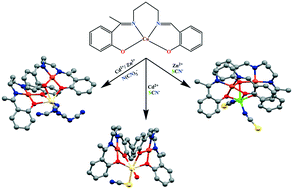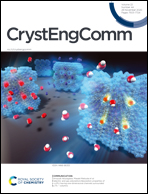Recurrent π(arene)⋯π(chelate ring) motifs in four trinuclear CuII2MII (M = Cd/Zn) complexes derived from an unsymmetrical N2O2 donor ligand: structural and theoretical investigations†
Abstract
A Cu(II) complex [CuL] of an asymmetrically di-condensed N2O2 donor Schiff base ligand, N-α-methylsalicylidene-N′-salicylidene-1,3-propanediamine (H2L) has been employed towards the synthesis of four heterometallic complexes, [(CuL)2Zn(N(CN)2)2] (1) [(CuL)2Cd(N(CN)2)2] (2), [(CuL)2Zn(SCN)2]·CH3CN (3) and [(CuL)2Cd(SCN)(H2O)]·ClO4 (4). All four complexes are found to be discrete bent trinuclear where two [CuL] units are coordinated to the central metal ion (Zn/Cd) via phenoxido oxygen atoms. In addition to two double phenoxido bridges, two monodentate dicyanamide ions in 1 and 2, two N-bonded thiocyanate in 3 and one S-bonded thiocyanate and one water molecule in 4 complete the hexa-coordination around the central metal ions. Recurrent π(arene)⋯π(chelate ring) stacked motifs were detected in the solid state of all complexes that have been studied by means of DFT calculations, rationalized using molecular electrostatic potential (MEP) surface calculations and characterized using the noncovalent interaction plot (NCIplot). The data presented herein show that the π(arene)⋯π(chelate ring) stacking interactions in complexes 1–4 are strong and relevant for determining their crystal packing.



 Please wait while we load your content...
Please wait while we load your content...